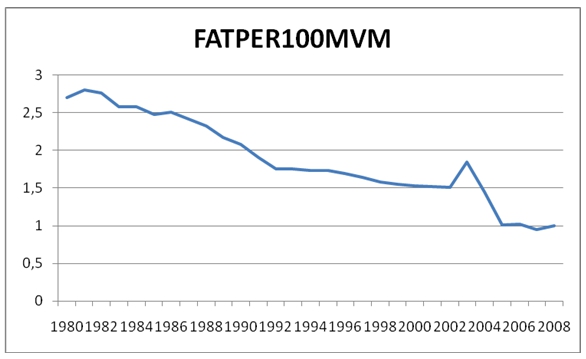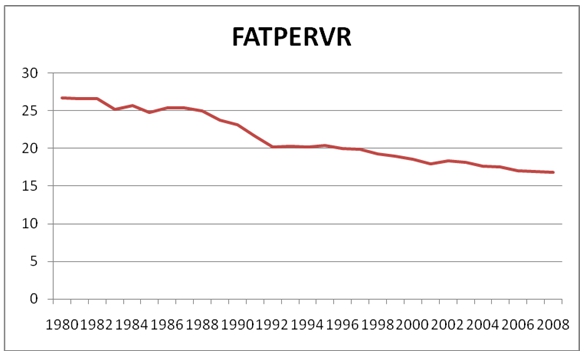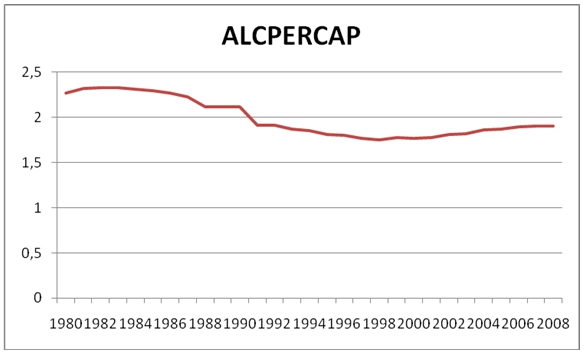Introduction
A seat belt, or as it is often called a safety belt is generally intended to save lives in extreme on-road situations. The fact is that there are too many arguments on the matters of using safety belts in everyday driving, as some argue these belts restrict movements and often prevent people from safe leaving a crashed car, the others claim that the implementation of the safety belt legislation helped to decrease the number of fatalities essentially.
This paper aims to review the legislation associated with the use of safety belts in motor vehicles and analyze the numbers, associated with road accidents. The comparison of various indexes is required for the objective estimation of the data, associated with the use of the seat belts, and the aspects of implementing the corresponding legislation.
The background of the research is based on the aspects of the statistical data and concepts, associated with the fatalities and car crashes. Originally, such indexes as Fatalities per Vehicle registered, Fatalities per population, Alcohol per Capita and time series will be analyzed.
Data Reviews and Analysis
To begin with, it should be stated that the first seatbelt laws were adopted in 1985 in New Jersey (Kneuper and Yandle, 163). Originally, the seatbelt laws vary from state to state, and the main difference is in the obligation level for the front passengers and rear passengers. Considering the fact, that the front passenger is obliged to buckle up, the violation of this law may cause fining. Anyway, independently of the size of the fine stated by the legislation, the largest fine for not buckling up is life. Thus, the legislation was adopted from the position of safety considerations.
Analyzing the data and various indexes, associated with the safety belt usage, the most crucial is the FATPER100MVM index. Thus, in accordance with the provided data, the number of fatalities tend to decrease since the adoption of the safety seatbelt law. Thus, by the diagram, the FATPER100MVM index showed a significant fall. Considering the fact, that this was also caused by the increased safety standards towards car manufacturing, the allover tendency appeared to be rather positive.

In the light of this statement, the original value of the seatbelt’s legislation is explained by the necessity to oblige people to protect their loved ones, as negligence towards safety often ends up with a disaster. Nevertheless, if health and life are not precious enough for people, money fines will be an effective tool of influence. Nevertheless, as it has been emphasized, the decrease of the FATPER100MVM index may depend not only on the legislation.
Fatalities per vehicle registered index is another significant indicator, which reveals the tendency for fatalities to decrease after the adoption of the seatbelt legislation.

Considering the values of the indexes, and the data provided, it should be emphasized that the necessity to analyze the provided data is closely associated with the aspects of legislation development. Thus, while the initial variant of the seatbelt legislation obliged only drivers and front passengers to be buckled up. Later, with the invention of the seat for kids, the corresponding amendments in the legislation helped to decrease the number of fatalities among children (Schmidt, Young and Ayres, 126).
Data Analysis
Data on the aspects of seatbelt legislation and the statistical indicators, associated with the use of seatbelts, is generally provided with a clear statement of the number of victims. Originally, the indexes, which characterize the allover image of statistical researches, reveal the strong tendency for the decrease of the number of fatalities. Nevertheless, this decrease was caused not only by the implementation of seatbelt legislation. Considering the fact, that there are lots of other legislations, aimed to provide on road safety, the seatbelt legislation is only a part of these statistical data.

The provided diagram reveals the ALCPERCAP index, and the tendency for alcohol consumption while driving. Thus, it should be stated that the slight increase of the index, starting from the year 2002, could not promote the decrease in the amounts of fatalities. Thus, the possible reasons for this decrease may be the implementation and development of the seatbelt legislation, the improved car manufacturing standards concerning driving safety, and passengers’ safety. Originally, it should be stated that in accordance with the legislation, concerning buckling up, this violation is often secondary, as policemen are not able to mention whether the seatbelt is fastened or not. Consequently, the mechanism of executing the legislation rules is not effective by its origin. In the light of this statement, it should be emphasized that the values of on-road safety are closely associated with matters of human responsibility.
Discussion
The implementation of the seatbelt legislation has originated numerous arguments and discussions. It should be stated, that the obligation to buckle up is considered an obligation, and in some states, a driver is responsible for his passengers. Nevertheless, the very fact of obligation makes others argue that it is a violation of civil rights and the infringement of civil liberties. The key arguments are associated with the statement, that everyone is responsible for his or her own life, and not wearing a seatbelt is not a crime against others. As it is stated by Houston, Lilliard and Neeley (163):
Not wearing seat belts is a victimless crime as the only person harmed is the one making that decision for himself about his own life. They also believe that since deaths are caused by seatbelts in some kinds of accidents that the government has no right to legislate an activity (buckling up) that may cause a person’s death in the hopes it will maybe save others. Opponents quote Benjamin Franklin who said “They that can give up essential liberty to obtain a little temporary safety deserve neither liberty nor safety”
In the light of this statement, it should be emphasized that the obligation to fasten the seatbelts cannot be considered as a fully life-saving measure, as the instances of car accidents, when the seatbelt became the reason for the accident are not rare, consequently, there is strong necessity to leave the choice up to drivers’ decision.
On the other hand, the necessity to buckle up also has the economic origin. Thus, in accordance with the research by Houston, Lilliard and Neeley (174), the victims of the car crash accidents, who were buckled up, cost hospitals 25% less in comparison with those, who preferred not to fasten the safety belt. Nevertheless, this argument has its counterargument, which stands for leaving the choice for the independent decision, as the citizens are not obliged to serve the economic interests of the State and government, while governments are intended to grant and defend the social liberties and freedoms of the citizens. Moreover, the statement that people are obliged to give up their freedoms for the state could benefit is absolutely unconstitutional and anti-humane.
The analysis of the New Jersey legislation, concerning the aspects of fastening seat belts while driving a motor vehicle gives the general representation on the matters of the general safety policy in the state. In general, it is stated in NJS 39:3-76.2f that everyone is obliged to buckle up, independently of the type of vehicle (excluding those, which are not equipped with safety belts). This law was primarily affected in 2000. The legislation of New Jersey has the necessary amendment, concerning the issues of responsibility:
Applies to all passengers, who are at least 8 years of age but less than 18 years of age, and each driver and front-seat passenger of a passenger automobile operated on a street or highway. All of these occupants are required to wear a properly adjusted and fastened seat belt system (Department of Law & Public Safety).
In the light of this statement, it should be emphasized that all the drivers will have to buckle up the young passengers, and this amendment is aimed at decreasing the fatalities among children. An essential improvement was adopted, concerning the matters of increased fatality values among passengers who were not buckled up.
Thus, on January 18, 2010, the amendment was adopted, claiming that all the passengers, independently on their seating position, should be buckled up. Additionally, the secondary offense issue had been adopted. It is stated that the officer has the right to summon a driver for the not fastened seat belt if the car was stopped for another violation. Originally, the first legislation concerning buckling up in New Jersey was adopted in 03.01.85. The primary enforcement is effective since 05.01.00 (secondary for rear seat occupants; effective from 1.20.11)
Variables Analysis
The analysis of the variables, concerning the aspects of seatbelt legislation is closely associated with the aspects of the traditional approach towards researching the problem. The problem of decreasing the fatalities in car crash accidents required the adoption of special standards and rules concerning the safety means for regulating road safety. Thus, the manufacturing standards were raised, and the legislation, which was adopted, was based on the statistical data on the matters of fatalities and the amount of car crash accidents, associated with the violation of safety rules and legislation. The variables of these issues are the following:
- FATPER100MVM (Fatalities per 100 MVM) – the number of lethal accidents and fatalities per every 100 motor vehicles
- FATPERVR (Fatalities per Vehicle registered) – the number of lethal accidents and fatalities per vehicle registered
- FATPERPOP (Fatalities per population) – the number of lethal accidents and fatalities for the entire population in general
- AlCPERCAP (Alcohol per Capita) – the amount of alcohol consumption
- PSBL (Primary Seat Belt Law). “Primary seat belt laws allow law enforcement officers to ticket a driver for not wearing a seat belt, without any other traffic offense taking place” (Kneuper and Yandle, 147)
- T – Time series
The analysis of these variables is closely associated with the necessity to estimate the actual on-road situation and analyze the tendencies, closely linked with the adoption of the rules and laws. Thus, the data, represented in the data analysis part of the research is aimed to define the development of the situation. Thus, the adoption of the law may be regarded as an inert tool, as some time required for the legislation had its actual effect. Moreover, it should be emphasized that the real necessity to implement the indexes is closely associated with the necessity to monitor the situation’s development. Thus, the legislative aspects, associated with traditional regulation, played an essential role in restricting the number of fatalities on the road. Fatalities per population being the dependent variable, one could tell that alcohol per capita (ALCPERCAP) is the most significant with a 0.00% probability the lower the figure, the more significant the variable is, thus alcohol consumption, in this case, is the highest contributory factor to automobile collision and the more collisions we have, the more probable fatalities we will experience. Average unemployment (AVEUNEMP) is another variable in this case. This variable is quite significant with 0.18% but the population of unemployed contributing to fatalities aren’t as much as the population who consume alcohol causing more accidents.
Recommendations
The recommendations, that should be given are closely associated with the regulatory practices of the state legislature and the necessity for the further decrease of the fatalities in car crash accidents. Thus, there is a strong necessity to mention that the number of fatalities depends not only on the buckling up but also on numerous other factors. Originally, the instances, when the chest appeared to be broken by the seatbelt, are not rear. Nevertheless, it is unknown, whether a human would stay alive if he or she was not buckled up. Consequently, in order to further improve the legislation system, there is a strong necessity to evaluate all the pros and cons, as well as develop a strong system of arguments and counterarguments, for the opponents of this legislation to ease up. In accordance with Kneuper and Yandle (205)[6], the following statement should be emphasized:
There is good evidence that habitually unbelted drivers will take more risks when belted, and that habitually belted drivers will be more cautious when unbelted, by the nature of laws, new drivers will be habituated from the outset. Thus, this rule relating car casualties to the level of car ownership has continued to hold across several decades of safety interventions, including seat belt laws. It is emphasized that drivers are also habituated from the outside to greater expectations of car performance. Alternatively, it is theorized that improvements are due to the increasing profile of safety interventions as car ownership increases as road safety professionals prefer.
Consequently, there is no necessity to rely upon the preferences and considerations of the average people and enthusiastic politicians who lobby these laws. There is a strong necessity to consider the point of view of experts and engineers, who are responsible for the safety of car driving, as these people project the car safety, and all their efforts are directed at maintaining the safety level high and resorting to the latest technologies for protecting the lives of car consumers.
A special emphasis should be made on the aspects of children’s safety. Considering the fact that these are the least protected participants of the traffic, the legislation system should relate not only the buckling up, and the presence of the special seat, nevertheless, the safety rules will be more important and reliable if the special speed regime will be implemented for the vehicles with kids on board. Consequently, the amount of car crash accidents, caused at least by the loss of vehicle control will decrease. Moreover, children will be more protected, and the strikes will be less fatal for them.
Conclusion
Finally, it should be stated that the legislation system, aimed to regulate the aspects of fastening seatbelts is aimed at decreasing the number of fatalities during car crash accidents. The basis of the concept is associated with the aspects of the statistical data and concepts, associated with fatalities and car crashes. The analysis of the related indexes is important for the definition of the tendencies, related to car crash accidents, and the curves, representing these indexes, help to define, whether the legislation adoption and increase of the standards are helpful or not.
In spite of the fact, that the adoption of the legislation is an effective tool, there are a lot of opponents of such legislation, who claim that the restriction of civil freedoms and liberties by obliging people to buckle up is anti-democratic and anti-humane. Nevertheless, the counterarguments are more effective and persuading.
References
Kneuper, Robert, and Bruce Yandle. “The Air Bag/seat Belt Controversy: How the States Voted.” Eastern Economic Journal 22.2 (1996): 147.
Schmidt, Richard A., Douglas E. Young, and Thomas J. Ayres. “Automobile Seat Belts: Usage Patterns in Automatic Belt Systems.” Human Factors 40.1 (1998): 126.
Houston, David J., E. Jr. Richardson Lilliard, and Grant W. Neeley. “The Effectiveness of Child Safety Seat Laws in the Fifty States.” Policy Studies Review 18.1 (2001): 163.
Department of Law & Public Safety. Seat / Belt Laws. The State of New Jersey, Office of Attorney General. 2010. Web.